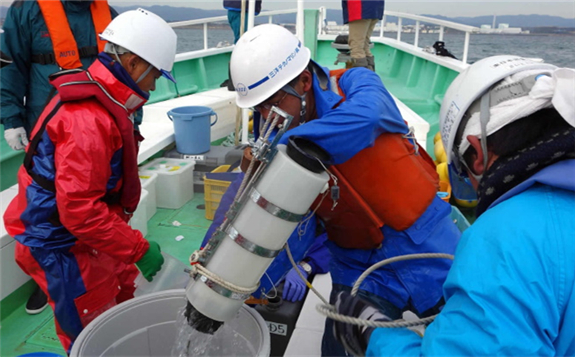Three independent Japanese experts are to monitor the collection of marine samples near the damaged Fukushima Daiichi nuclear power plant on behalf of the International Atomic Energy Agency (IAEA). The aim is to support the quality assurance of data collection and analysis by Japanese laboratories for radioactivity measurements.

The 4-20 November mission is the tenth organised by the IAEA, at the request of the Japanese government, to verify that sea area monitoring around the plant remains comprehensive, credible and transparent. In the previous nine such missions, the IAEA sent its own team including international experts. However, due to COVID-19 travel restrictions, three Japanese experts commissioned by the IAEA will this time observe and document the sampling.
The IAEA has since 2014 organised missions to support the collection of marine samples for interlaboratory comparisons of radioactivity analyses. For this mission, the independent domestic experts in environmental radioactivity will observe the sample collection of seawater and marine sediment samples near the Fukushima Daiichi plant, and fish caught by commercial fishing operations in Fukushima Prefecture.
The team will report directly to the IAEA on the integrity of sample collection, identification, tracking and pre-treatment. Analyses of the samples will be conducted at laboratories in Japan and at the IAEA, where the quality of the measurement results will be evaluated.
In August 2017, following a review of data, the IAEA said that analyses by Japanese laboratories of seawater, marine sediment and fish samples taken from near the damaged Fukushima Daiichi plant produce reliable data. The agency compared the results obtained from seven Japanese labs with those from three labs outside Japan. The three-year project was a follow-up activity to recommendations made on marine monitoring in a report by the IAEA in 2013, which reviewed Japan's efforts to plan and implement decommissioning of the plant.
At the Fukushima Daiichi site, contaminated water is treated by the Advanced Liquid Processing System (ALPS), which removes most of the radioactive contamination, with the exception of tritium. This treated water is currently stored on site. As of 12 March, some 1.19 million cubic metres of treated water are stored within 979 tanks on the plant site. The total tank storage capacity will amount to approximately 1.37 million cubic metres by the end of 2020 and all the tanks are expected to be full around the summer of 2022.
In March this year, Tokyo Electric Power Company (Tepco) released a report on two potential methods for disposing of treated water currently being stored on the plant site. The report considered the discharge of the water into the sea and via vapour release. Tepco said that, if released into the sea, the amount of radioactive materials other than tritium in the stored water will be reduced as much as possible, while the tritium concentration will also be lowered as much as possible.
In April, the IAEA said the two options under consideration for disposing of this water - discharge into the sea and via vapour release - are both technically feasible. It noted water management, including the treated water disposal, was "critical to the sustainability of the Fukushima Daiichi decommissioning activities". It called for a decision on the disposition path for the stored treated water to be taken urgently, considering safety aspects and engaging all stakeholders.
The government will have the final authority to decide which disposal policy to implement. On 28 October, Japanese Prime Minister Yoshihide Suga said his government was working on the final details of a plan to release the stored water at the Fukushima Daiichi plant.
"We cannot put off our decision forever without making a plan," Suga was quoted as saying by the Associated Press. "Based on discussions and expertise we've had, we will further deepen our discussion and responsibly make a decision at an appropriate time."